After the usual morning rituals we made a quick plan for the day. We would both go down to the sea front and observe the raw, balmy sea, and then I would head off to Leeuwarden for a culture fix. Rex was going to stay behind, he wanted to try and fix a problem on the tablet he had bought for use as a backup chart-plotter, plus a few other odd jobs. More importantly, as far as I was concerned he needed to rest up in a warm place; he clearly was not well with a cold.
The sea scowled at us, presenting itself as a cold, grey, seething clash of waves. The dancing buoys along the long channel stretching out into the Waddenzee were leaning over at an alarming angle, and a vicious current ran up through the ferry harbour.
 A Single Ferry and Lone Dredger on the Stormy Waddenzee |
 Boy With His Finger in the Dyke |
We parted company, and I headed in the rain to the harbour train station, watching a train just leaving as I forced my way through the gale. A huddle of windswept souls sheltered in the small waiting area on the platform. Collectively we watched a convoy of tractors pass by the rail head. There must be a rally on I thought. Then a fleet of helicopters seemed to follow on. The din was actually very old tractors, perhaps with two-stroke engines. As if in accompaniment, the wind whistled through the charmless shelter.
 "Love" by Jaume Plensa |
Leeuwarden is the capital of Friesland and one of the historical eleven cities. It developed out of three terp or hill settlements that originally stood on an expanse of water known as the Middelzee. These merged in 1435 and were granted a municipal charter. Thereafter the town grew into an important trading center. With the silting up of the Middelzee, however, the town lost its harbour and became instead an agricultural market town and the chief center of the Ostergos region. From 1524 to 1580 the town was the seat of the Habsburg Stadholder, who was succeeded from 1584 to 1747 by Stadholders of the Nassau-Dietz family. In the 16th-18th centuries Leeuwarden was famed for its fine gold and silverware. Nowadays Leeuwarden is a modern city with a mostly 16th century city centre, with many canals and city walls (the structure of the city walls looks like a diamond) and museums. It is a university city with a laidback provincial air, its centre a haphazard blend of modern glass and traditional gabled terraces overlooking canals. It perhaps lacks the concentrated historic charm of many other Dutch cities, but it's an amiable old place.
Several notable people were born in Leeuwarden: the artist Escher, Saskia van Uylenburgh, Rembrandt's wife, and of course the city's most famous daughter, the spy Mata Hari (1876-1917). She was born Gertrud Zelle. Hari became a renowned "exotic" dancer after an early but unsuccessful marriage to a Dutch army officer. Although the Netherlands was neutral during World War I, Hari seems to have accepted a German bribe to spy for the kaiser. The French intelligence service soon got wind of the bribe - partly because she was also supposed to be working for them - and she was subsequently arrested, tried and shot. What she actually did remains a matter of some debate, but in retrospect it seems likely that she acted as a double agent, gathering information for the Allies while giving snippets to the Germans.
 Typically Dutch |
I headed off to Eewal, passing familiar sights on the way. Soon I was strolling down Eewal, and I quickly located the Galerie de Roos van Tudor. I entered, giving the gallery a cursory glance as I did so. Paintings hung on walls indicated that they were produced by a diverse group.
A smartly dressed lady in a white suit, probably in her late 50s, came down a flight of stairs and came to greet me. "It is bad weather outside," she smiled. "It's even worse in Harlingen," I laughed. "Oh, really. Are you on holiday there?" "I am sailing a small boat with a friend, and we are staying there until the storms die down." "Where did you sail from in Britain?" "East Anglia," and I pointed it out on a map. "I have visited England and Scotland a few times: Edinburgh for the Tatoo and Festival, the Lake District, Oxford and the Isle of Wight. Me and my husband travel by motorcycle, catching the ferry from Ijmuiden to Newcastle, and coming back via the Channel Tunnel. We love it."
She explained how the gallery had in May ushered in the colourful summer salon "Colours" with works by various artists and guest artists. Paintings, graphics, bronze statues, photographs, mixed media and ceramics could be seen around the large room. The gallery had focused for 30 years on contemporary art by both fledgling and established Dutch artists. In September 1987, Anita van Os took over the Rose of Tudor from Thom Mercuur, the founder of the Belvedere museum. At least six solo or group exhibitions were held each year in the gallery. In addition the gallery was instrumental in organizing and participating in both national and international art fairs and exhibitions.
She soon ascertained my tastes in art, and what I found of interest in her collection from a group of 30 artists. Once armed with that information, she set about showing me more examples of selected artist's work. Having limited space, the gallery had a batch of sliding display walls, each wall featuring a different artist, that Anita could pull out.
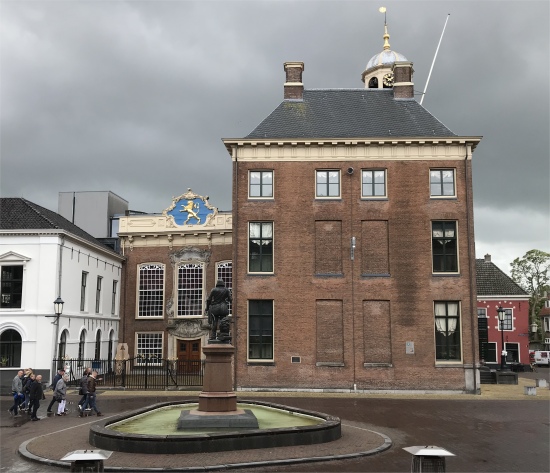 1715 Stadhuis |
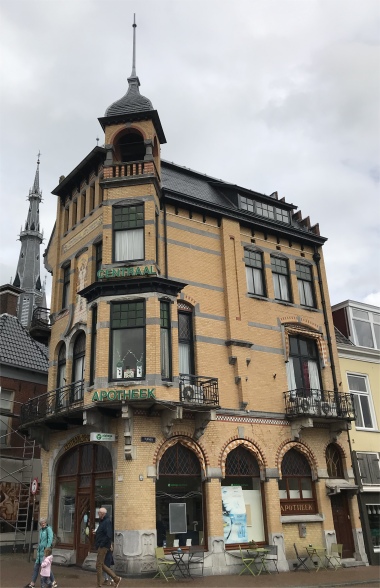 1854 Centraal Apotheek |
 St Bonifatiuskerk |
I stood for a while gazing up at the towering St Bonifatiuskerk, a neo-Gothic church built by P. J. H. Cuypers in 1882-84. During a hurricane in 1977 the upper portion of the steeple was completely torn off and fell to the ground. In the 1980's the 78m steeple was rebuilt, this time using a steel construction.
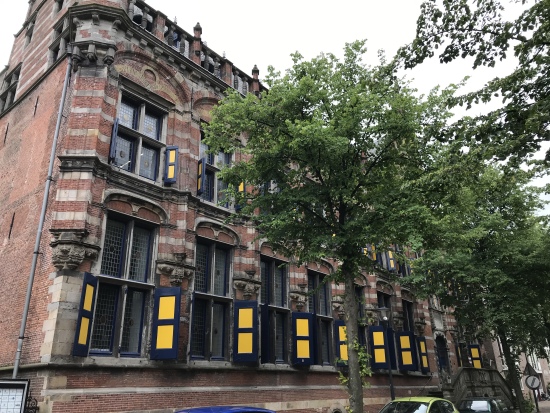 Kanselarij |
 Waag (Weighing House) |
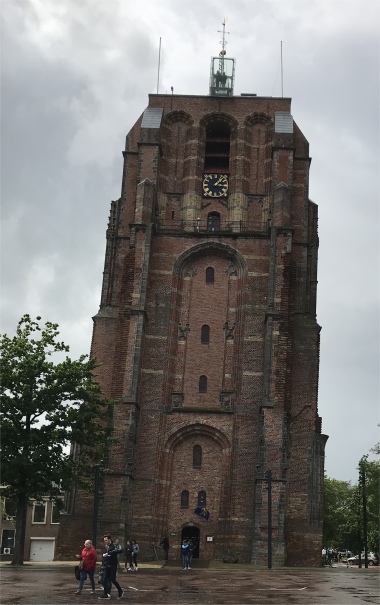 Oldehove |
There is a square, the Oldehoofsterkerkhof, situated at the foot of the leaning tower Oldehove. A long time ago there was a church on the Oldehoofsterkerkhof, and like the name suggests this used to be a cemetery. Some time ago the bodies in the graveyard were exhumed and now you can park your car in that very same spot in the underground parking garage. In the summer little fountains spew water over the square and its red cobblestones. The square in front of the Oldehove has been lowered so that in a period of frost a small layer of water will create an ice rink for recreational ice skating.
 Fries Museum in the Rain |
Two exhibitions were on currently. One featured aerial photographs of the Elfstedter, the original eleven cities of Friesland, by Hans Wilschut. Paved roads, railway lines and canals: Friesland has changed a great deal over the past centuries. In the 18th century draughtsmen criss-crossed the province to map these changes as accurately as possible. Photographer Hans Wilschut is inspired by their prints. He documents the Frisian urban landscape of today. Wilschut not only records the cities, but also photographs Drachten and Heerenveen, two places that can hardly be called villages anymore. The Museum of Friesland commissioned these photographs from Hans Wilschut. He travels through the Frisian countryside with a cherry picker and waits until daylight is perfect before he takes his photos.
Like the 18th-century draughtsmen Wilschut records changes in the landscape. In his photograph of Stavoren, for example, he does not show the famous statue of the Lady of Stavoren, but a burnt-down hotel. The company wants to expand to the vacant land shown in the photo in front of and behind the building. Meanwhile, in the background are houses built in a style typical of this tourist city.
The other exhibition featured scuptures by Éric Van Hove, who was born in 1975 in Guelma (Algeria). He grew up in Cameroon as the son of engineers involved in development projects. When he was 14, the family returned to Belgium. After his studies at the art academy in Brussels he went to Japan, where he obtained his Master's and PHD. After that he briefly lived in Belgium before moving to Marrakech more permanently. In 2014 he made his international breakthrough thanks to his participation in the Marrakech Biennale.
It was during his stay in Morocco that he began to take a deep interest in all manner of engines. The Mercedes-240 is mostly used as a taxi in Morocco, where its German origin and reputation for quality and indestructibility have made the vehicle a status symbol. The Moroccan's ability to cannibalise old taxis in order to keep existing ones going fascinated him. Indeed it is said that some taxis have done several million miles due to such recycling of engine parts. Van Hove built his Dorigin entirely from Mercedes-240 parts and drove it to its country of origin, where the car is seen more as Moroccan than as a typical German product. In this way, the work of art poses questions about identity and ownership.
For the artist, the engine symbolises industrialisation, which in many countries marked the end of traditional craftsmanship. Production line work has replaced handcrafts. With his impressive replicas, Van Hove puts traditional crafts back on the map. He combines the beauty of design with current themes such as the distribution of wealth and the disparities between the West and the rest of the world.
Glossy wood, shiny copper, polished mother of pearl: materials from all over the world are combined in the traditionally reproduced engines of Éric Van Hove. From the smallest screw to the cylinder head: international craftsmen handcraft each part under the direction of Van Hove.
The highlight of the exhibition is the D9T, a reproduction of a Caterpillar D9 bulldozer engine. Initially this vehicle was designed for construction projects in developing countries. Since the Vietnam War, this bulldozer has often been used by regimes to suppress uprisings and riots and as barricades. Because of this, the bulldozer has come to symbolise oppression instead of construction. Van Hove's reproduction consists of 295 parts, made from 46 materials by 41 different craftsmen. The artwork consists of engraved cedar wood from the Atlas Mountains, carved purpleheart wood from Brazil, wenge wood from Congo and tatajuba wood from Suriname, as well as materials such as polished mother of pearl, bones, ceramics, marble, copper and tin.
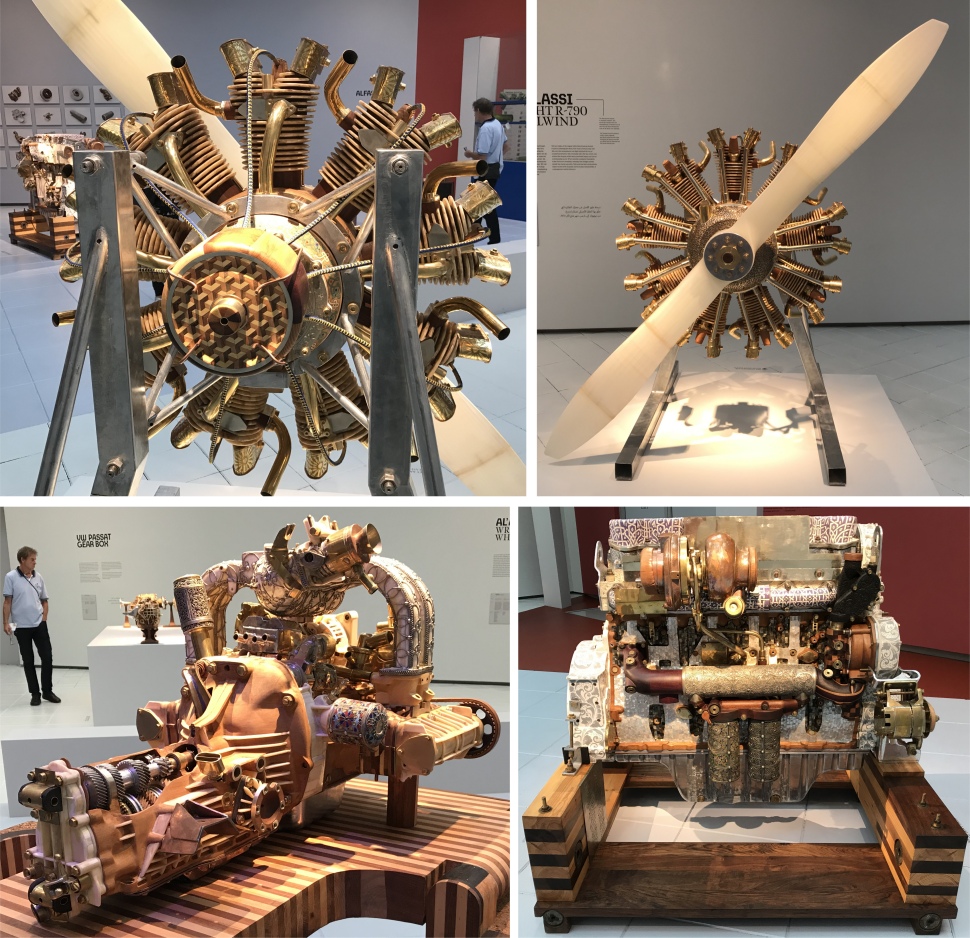 Éric Van Hove Exhibition |
The lady sitting adjacent to me exclaimed, "Oh dear, what is happening?" Rex sheepishly explained what had happened, and I complimented the woman on her perfect English. She detected a northern lilt in my voice. "I grew up in the northwest of England," I explained. "Oh, my husband and I have friends in the northeast, in Newcastle, and we often get the ferry there from Ijmuiden. Look, he's wearing a Newcastle football shirt," she told me, pointing to a chap further along the bar with his mates. "Why aye man. Me and me son often ga to watch football at St. James's Park," he shouted in his best Geordie, grinning from ear to ear. His wife showed us photos taken of her husband, son and friends at one of the matches. I knew from earlier visits to Harlingen that during the 80s, many men from the declining shipyards in the northeast of England went to Harlingen to work in the thriving shipyards there. Many married local girls and stayed. The woman's husband was a Dutchman though.
She related to me how she used to live in Harlingen, quite close to the marina where we were berthed, but when she got married, her husband already had a house in a nearby village, so they lived there. When their children had grown up, the couple moved to Harlingen. Her husband periodically drifted into a Geordie twang, and when he did so his mates teased him and chanted a song in English taking the micky out of Geordies, perhaps a common chant in the shipyards. Peels of laughter rang out.
The small chap who had placed the bet when England played football against Holland recently was also in the bar tonight. I mentioned to the lady how he had lost his bet. She laughed, saying he could afford it; he owned the Pompeii restaurant in town. The gambler started to receive some ribbing from other blokes in the bar, mocking his football team, Ajax. Then it transpired that the big chap, who was the billiards ace, supported Rotterdam, and together with "Geordie" supporting Newcastle, the bar erupted into endless banter, teasing and laughter.
The lady advised us of a good restaurant in the Anna Casparii, a pub by the Noordhaven. So, after bidding all present in the bar farewell, we retired to the restaurant and enjoyed excellent Dutch food.
